Notebook of William Blake
The Notebook of William Blake (also known as the Rossetti Manuscript from its association with its former owner Dante Gabriel Rossetti) was used by William Blake as a commonplace book from c. 1787 (or 1793) to 1818.

Description
The Notebook [Butlin #201] consists of 58 leaves and contains autograph drafts by Blake of poems and prose with numerous sketches and designs, mostly in pencil. Containing two pages of preface, alongside 94 pages of sketches, each page is approximately 159 x 197mm. The original leaves were later bound with a partial copy (ff. 62–94) of 'All that is of any value in the foregoing pages' that is Rossettis' transcription of Blake's notebook (added after 1847).[1]

Ideas of Good & Evil
At first the Notebook belonged to Blake's favourite younger brother and pupil Robert who made a few pencil sketches and ink-and-wash drawings in it. After death of Robert in February 1787, Blake inherited the volume beginning it with the series of sketches for many emblematic designs on a theme of life of a man from his birth to death. Then, reversing the book he wrote on its last pages a series of poems of c. 1793. He continued the book in 1800s returning to the first pages. All together the Notebook contains about 170 poems plus fragments of prose: Memoranda (1807), Draft for Prospectus of the Engraving of Chaucer's Canterbury Pilgrims (1809), Public Address (1810), A Vision of the Last Judgment (1810). The latest work in the Notebook is a long and elaborated but unfinished poem The Everlasting Gospel dated c. 1818.
On the page 4 is placed a short humorous poem "When a Man has Married a Wife..." and a picture above showing of a man and woman rising from bed in a sparsely furnished room that could be Blake's own. The line of text obscured by the picture "Ideas of Good & Evil" served probably as a title to 64 following picture emblems, 17 of which were used for the book "For Children: The Gates of Paradise". D. G. Rossetti,[2] A. C. Swinburne,[3] and W. B. Yeats[4] in their publications of Blake's poetry used this as a title for the series of poems from the manuscripts. In 1905 John Sampson issued the first annotated publication of all these poems and created a detailed descriptive Index to 'The Rossettt MS.'.[5] It follows by some other scholarly publications edited by Geoffrey Keynes (1935 & 1957/66), David V. Erdman (1965/82/88) & together with D. K. Moore (1977), Alicia Ostriker (1977), Gerald E. Bentley Jr. (1977), etc.
In the introduction of his publication D. G. Rossetti gave to these poems a following presentation:
“The shorter poems, and even the fragments, afford many instances of that exquisite metrical gift and rightness in point of form which constitute Blake's special glory among his contemporaries, even more eminently perhaps than the grander command of mental resources which is also his. Such qualities of pure perfection in writing verse, as he perpetually, without effort, displayed, are to be met with among those elder poets whom he loved, and such again are now looked upon as the peculiar trophies of a school which has arisen since his time; but he alone (let it be repeated and remembered) possessed them then, and possessed them in clear completeness. Colour and metre, these are the true patents of nobility in painting and poetry, taking precedence of all intellectual claims; and it is by virtue of these, first of all, that Blake holds, in both arts, a rank which cannot be taken from him."[6]
Poems of 1793
The section of c. 1793 contains 63 poems that include drafts versions of 16 poems entered the collection of Songs of Experience, which have been placed here in the following order:

Some of these drafts are significantly different from their last versions, for example "Infant Sorrow" of the Notebook is much more expanded and composed of nine quatrains instead of two that were chosen for the Songs of Experience. Also it is interesting to compare the most famous Blake's poem "The Tyger" with its two earlier Notebook versions (see: "The Tyger", 1st draft and 2nd draft).
The genre of most of the poems of this section can be defined as Songs and Ballads. Some of them reflect the political and social climate of that time:


Why should I care for the men of thames
Or the cheating waves of charterd streams
Or shrink at the little blasts of fear
That the hireling blows into my ear
Tho born on the cheating banks of Thames
Tho his waters bathed my infant limbs
The Ohio shall wash his stains from me
I was born a slave but I go to be free[7]
Silent Silent Night
Quench the holy light
Of thy torches bright
For possessd of Day
Thousand spirits stray
That sweet joys betray
Why should joys be sweet
Used with deceit
Nor with sorrows meet
But an honest joy
Does itself destroy
For a harlot coy[8]
Some other of these poems rather belong to the genre of Satiric verses and epigrams, like the following:
Motto to the Songs of Innocence and of Experience
The Good are attracted by Mens perceptions
And Think not for themselves
Till Experience teaches them to catch
And to cage the Fairies and Elves
And then the Knave begins to snarl
And the Hypocrite to howl
And all his good Friends shew their private ends
And the Eagle is known from the Owl[9]
This motto, which was never engraved by Blake, is not found in any copy of the Songs of Innocence and of Experience.
Poems of 1800–1803
There are 10 poems in the Notebook written during Blake's life in Felpham, a village in West Sussex. Here is the one of his most characteristic poems of that period:
Mock on Mock on Voltaire Rousseau
Mock on Mock on! tis all in vain!
You throw the sand against the wind
And the wind blows it back again
And every sand becomes a Gem
Reflected in the beams divine
Blown back they blind the mocking Eye
But still in Israels paths they shine
The Atoms of Democritus
And Newtons Particles of light
Are sands upon the Red sea shore
Where Israels tents do shine so bright[10]
Poems of 1808–1811
The most of 92 texts of this section are epigrams, gnomic verses or fragments addressed to Blake's friends and enemies, to painters and poets as well as some different historical or mythological characters and even to God. Here are typical examples:

Was I angry with Hayley who usd me so ill
Or can I be angry with Felphams old Mill
Or angry with Flaxman or Cromek or Stothard
Or poor Schiavonetti whom they to death botherd
Or angry with Macklin or Boydel or Bowyer
Because they did not say O what a Beau ye are
At a Friends Errors Anger shew
Mirth at the Errors of a Foe[11]
If you have formd a Circle to go into
Go into it yourself & see how you would do[12]
In the following short fragment Blake speaks of himself and his own spiritual experience in his babyhood:
The Angel that presided oer my birth
Said Little creature formd of Joy & Mirth
Go love without the help of any King on Earth[13]
There is also a draft of famous Blake's motto from his poem Jerusalem The Emanation of the Giant Albion:
I give you the end of a golden string,
Only wind it into a ball:
It will lead you in at Heavens gate,
Built in Jerusalems wall.<ref>Erdman 1988, p. 231.</ref>
But there in "Jerusalem" at the beginning of the chapter 4 ("To the Christians") it is given in a combination with other 4 mysterious lines:
| Devils are | I give you the end of a golden string, |
| False Religions | Only wind it into a ball: |
| "Saul Saul" | It will lead you in at Heavens gate, |
| "Why persecutest thou me." | Built in Jerusalems wall. |
Designs
The Notebook is full of Blake's sketches and designs almost on every page. Here is the index of the first 25 pages (see illustrations below):
| p. 2. | Sketch (pencil). — Daphne? (central emblem). |
| p. 4. | Title-page. — Ideas of Good & Evil. Sketch (pencil). — A young woman dressing (central emblem). |
| p. 5. | Sketch. (pen and ink) A man in a Roman toga |
| p. 6. | Sketch (pen and ink) Tiger. Tiger's head. A man hiding in a house. For the Designs to a Series of Ballads of William Hayley |
| p. 7. | Sketch (pencil). Three figures |
| p. 8. | Sketch (pencil). A composition with 2 or 3 figures |
| p. 9. | Sketch (sepia). attrib. to Robert Blake: "Lady Macduff fleeing one of Macbeth's henchmen" |
| p. 11. | Sketch (pencil). A composition with a few figures |
| p. 12. | Sketch (pencil). Head of a King? (obscured with the text, central emblem). |
| p. 13. | Sketch (sepia). attrib. to Robert Blake: Oberon and Titania Reclining on a Poppy (ill. to Shakespeare's A Midsummer Night's Dream?), Monochrome wash drawing, |
| p. 15. | Sketch (pencil). For Gates of Paradise. Traveller (central emblem). The urinating man. Flying monster with a man in his mouth (3 times) — Lucifer discovering Judas? (Inferno, Canto xxxiv.). A man with a dog. |
| p. 16. | Sketch (pencil). Flying monster with a man in his mouth (twice) — Lucifer discovering Judas? (Inferno, Canto xxxiv.). A man. A figure with children. |
| p. 17. | Sketch (pencil) Monster's Head with a man in his mouth (twice). Old man encounters his death (central emblem). |
| p. 18. | Sketch (pencil). A horseman with a lady following (central emblem). |
| p. 19. | Sketch (pencil). — For Gates of Paradise. Object 9: What are these? Alas! the Female Martyr Is She also the Divine Image (central emblem). |
| p. 20. | Sketch (pencil). Dispute (central emblem). |
| p. 21. | Sketch.— For Songs of Experience — 'The Sick Rose.' (central emblem, pencil). Man's head in profile (pen and ink). |
| p. 22. | Sketch (pencil). A composition with a few figures (heavily obscured with the text, central emblem). |
| p. 23. | Sketch (pencil). A figure inside of the cage hanged on the bow of a tree and anEagle (central emblem). |
| p. 24. | Sketch (pencil). A composition with 3 figures (central emblem). |
| p. 25. | Sketch (pencil). A composition with 5 figures – Pestilence? (central emblem). |
... and so on.
 Daphna? p.2
Daphna? p.2 attrib. to Robert Blake: "Lady Macduff fleeing one of Macbeth's henchmen", p.9
attrib. to Robert Blake: "Lady Macduff fleeing one of Macbeth's henchmen", p.9 Head of a King? p.12
Head of a King? p.12 Urinating man, p.15
Urinating man, p.15 Flying Monster, p.15
Flying Monster, p.15 Man & Dog, p.15
Man & Dog, p.15 Flying Monsters & Traveller, p.16
Flying Monsters & Traveller, p.16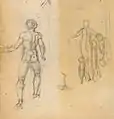 Traveller and Woman with children, p.16
Traveller and Woman with children, p.16 Two Monsters, p.17
Two Monsters, p.17 Encounter with Death, p.17
Encounter with Death, p.17 Horseman, p.18
Horseman, p.18 Woman's Head, p.19
Woman's Head, p.19 Dispute, p.20
Dispute, p.20 Man's Head, p.21
Man's Head, p.21 The Sick Rose, p.21
The Sick Rose, p.21 Cage on a tree, p.23
Cage on a tree, p.23 Scene, p.24
Scene, p.24 Pestilence? p.25
Pestilence? p.25 Portrait, p.47
Portrait, p.47 Man's Profile, p.54
Man's Profile, p.54 Selfportrait, p.67
Selfportrait, p.67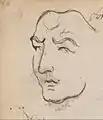 Sad Face, p.70
Sad Face, p.70 Tom Paine, p.74
Tom Paine, p.74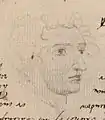 Catherine Blake? p.82
Catherine Blake? p.82
These sketches often serve as the sources for Blake's later works, illustrations of his books, engravings, watercolors, etc. Here are some examples:
| Image | Description | Image | Description | Image | Description |
|---|---|---|---|---|---|
 |
attrib. to Robert Blake: Oberon and Titania Reclining on a Poppy (ill. to Shakespeare's A Midsummer Night's Dream?), Monochrome wash drawing, c. 1786–87. Butlin 201.5(13), p.13 British Library, London, England |
 |
William Blake: Oberon and Titania (ill. to Shakespeare's A Midsummer Night's Dream?), from The Song of Los, copy A, Relief etching with color printing and hand colouring. 1795 object 5 British Museum |
 |
William Blake: Oberon and Titania (ill. to Shakespeare's A Midsummer Night's Dream?), from The Song of Los, copy C, Relief etching with color printing and hand colouring. 1795 object 5 Morgan Library and Museum, New York, USA |
 |
Tiger. Ink sketch from Notebook, p.6 |
 |
Tiger. Engraving from Designs to a Series of Ballads of William Hayley, copy 1, 1802, Henry E. Huntington Library and Art Gallery, San Marino, California, USA |
 |
The Tyger. Songs of Innocence and of Experience, copy Y, 1825, Metropolitan Museum of Art, New York, USA |
 |
The inscription: Thus the traveller hasteth in the Evening Pencil sketch from Notebook, p.15 |
 |
The Traveller hasteth in the Evening 14 Publishd [sic] 17 May 1793 by WBlake Lambeth Engraving from For Children. The Gates of Paradise, 1793, Library of Congress, Washington, D.C., USA |
 |
The Traveller hasteth in the Evening 14 Publishd [sic] 17 May 1793 by WBlake Lambeth Engraving from For the Sexes. The Gates of Paradise, copy D, c. 1825 Morgan Library and Museum |
 |
The inscription: Ah luckless babe born under cruel star |
 |
Alas! Engraving from For Children. The Gates of Paradise, copy D, object 9, 1793, Library of Congress |
 |
7 What are these? Alas! the Female Martyr Is She also the Divine Image Publishd [sic] 17 May 1793 by WBlake Lambeth Engraving from For the Sexes. The Gates of Paradise, 1825, object 9 Inscribed in graphite lower center: "7. One dies! Alas! the living and dead! One is slain! and one is fled! Blake's 'Key'." Yale Center for British Art at Yale University in downtown New Haven, Connecticut, USA Paul Mellon Collection |
 |
Oothoon & the Nymph-Marigold. Pencil sketch from Notebook, p.28 |
 |
Oothoon & the Nymph-Marigold. Relief etching with monotyped color from Visions of the Daughters of Albion, copy G, object 3, 1795 Houghton Library, Harvard University, Cambridge, Massachusetts, USA |
 |
Oothoon & the Nymph-Marigold. Relief etching with monotyped color from Visions of the Daughters of Albion, copy O, object 3, c. 1818 British Museum |
 |
Nebuchadnezzar. Pencil sketch from Notebook, p.44 |
.jpg.webp) |
Nebuchadnezzar. Colour print, ink and watercolour on paper, 1795/c.1805 Tate Britain, London, England |
 |
Nebuchadnezzar. Etching and watercolour on paper, The Marriage of Heaven and Hell, copy I, 1827 Fitzwilliam Museum, Cambridge, England. |
 |
(Without inscription) Count Ugolino and his sons in prison Pencil sketch from Notebook, p.59 |
 |
Does thy God O Priest take such vengeance as this? Engraving from For the Sexes. The Gates of Paradise, copy D, c. 1825 Morgan Library and Museum |
 |
Count Ugolino and his sons in prison (Ill. to Dante. Inferno Canto XXXIII 13–93) c.1826. pen, tempera and gold on panel Fitzwilliam Museum |
 |
The inscription: What we hope we see Pencil sketch from Notebook, p.61 |
 |
Fear & hope are – Vision. Engraving from For Children. The Gates of Paradise, 1793, Yale Center for British Art |
 |
Fear & hope are – Vision. Engraving from For the Sexes. The Gates of Paradise, copy D, c. 1825 Morgan Library and Museum |
 |
The inscription: I found him beneath a tree in the Garden Pencil sketch from Notebook, p.63 |
 |
I found him beneath a Tree Engraving from For Children. The Gates of Paradise, copy D, object 3, 1793, Library of Congress |
 |
I found him beneath a Tree Engraving from For the Sexes. The Gates of Paradise, copy D, object 3, c. 1825 Morgan Library and Museum |
 |
The inscription: he rears from off the pool His mighty stature Milton Pencil sketch from Notebook, p.91 |
 |
Fire Engraving from For Children. The Gates of Paradise, copy D, object 7, 1793, Library of Congress |
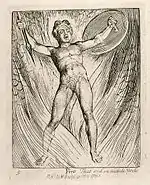 |
Fire Engraving from For the Sexes. The Gates of Paradise, copy D, object 7, c. 1825 Morgan Library and Museum |
 |
The inscription: Thou hast set thy heart as the heart of God- Ezekiel Two sketches (pencil and sepia) from Notebook, p.94 |
 |
Air Engraving from For Children. The Gates of Paradise, copy D, object 6, 1793, Library of Congress |
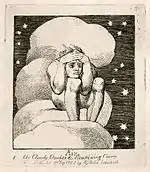 |
Air Engraving from For the Sexes. The Gates of Paradise, copy D, object 6, c. 1825 Morgan Library and Museum |
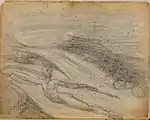 |
Satan with a shield and spear, sketch from Notebook, p.112 |  |
Satan Exulting over Eve. Graphite, pen and black ink, and watercolor over color print, illustration of Paradise Lost, 1795. 1795. The Getty Center, in Brentwood, Los Angeles, California, USA |
 |
Satan Exulting over Eve. Medium Colour print, ink and watercolour on paper mounted on canvas, illustration of Paradise Lost, 1795. Tate Britain |
Owners
The volume was presented by Catherine Blake (Blake's widow) in 1827 to William Palmer, brother of Blake's pupil, Samuel Palmer. It was bought from him by Dante Gabriel Rossetti 30 April 1847. Later it was purchased by F. S. Ellis (at Rossetti's sale, T. G. Wharton, Martin & Co., 5 July 1882, lot 487) and by Ellis and Scruton (at Ellis's sale, Sotheby's, 18 Nov 1885, lot 608). Sold by Dodd, Mead and Co. of New York (f. ib) to William Augustus White (d. 1928) of Brooklyn, 26 Jan 1887. Inherited by his daughter, Mrs Frances Hillard Emerson (d. 1957) of Cambridge, Massachusetts. Presented by Mrs F. H. Emerson. Now in the possession of British Library: Add MS 49460.
See also
Notes
- See: Rossetti Manuscript online: 1 2
- D. G. Rossetti (in Gilchrist, 1863/1880).
- Swinburne, 1868.
- Yeats, 1893/1905.
- Sampson, 1905.
- D. G. Rossetti (in Gilchrist, 1863/1880).
- Erdman 1988, p. 473.
- Erdman 1988, p. 471.
- Erdman 1988, p. 499.
- Erdman 1988, pp. 477-478.
- Erdman 1988, p. 504.
- Erdman 1988, p. 516.
- Erdman 1988, p. 502.
Bibliography
- 2nd vol. of Life of William Blake, by Alexander Gilchrist, D. G. Rossetti, W. M. Rossetti, Anne Gilchrist (Chapter: Ideas of good and evil), 1863 & 1880.
- A. C. Swinburne. William Blake, a critical essay (Chapter: Lyrical poems), 1868.
- The Poems of William Blake, ed. by W. B. Yeats, 1893, rev. 1905.
- The poetical works of William Blake; a new and verbatim text from the manuscript engraved and letterpress originals; With variorum readings and bibliographical notes and prefaces, edited by Sampson, John, Clarendon Press Oxford, 1905.
- The Note-book of William Blake, ed. G. Keynes, 1935
- Blake Complete Writings, ed. G. Keynes, Nonesuch press 1957, OUP 1966/85
- The Complete Poetry & Prose of William Blake, ed. by David V. Erdman, Anchor Books, 1965/1982/1988 (see also at the Blake archive)
- Erdman, Errors in the 1973 edition of The Notebook . . ., Blake Newsletter, ix, 1975, pp. 39, 40
- G. E. Bentley Jr., Blake Books, Oxford, 1977, pp. 321–34 and passim.
- William Blake The Complete Poems, ed. Alicia Ostriker, Penguin Books 1977
- The Notebook of William Blake, ed. D. V. Erdman and D. K. Moore, New York, 1977
- M. L. Greenberg, "The Rossettis transcription of Blake's notebook", and "William Michael Rossetti's transcription and William Bell Scott's tracings from Blake's notebook", The Library, 6th ser., iv, 1982, pp. 249–72, and vi, 1984, pp. 254–76.
External links
| Wikisource has original text related to this article: |
- Add MS 49460.
- The Notebook of William Blake on the British Library's website showing 112 pages, with related articles and collection items




